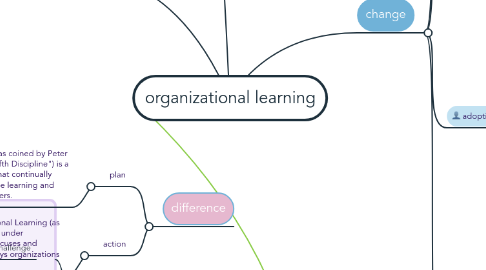
1. relationship between organizational learning, leadership and change
1.1. people
1.1.1. leadership
1.1.2. skills
1.1.3. workforce planning
1.1.4. values and culture
1.2. structure
1.2.1. reporting lines
1.2.2. roles and accountabilities
1.2.3. governance structures
1.2.4. geographic footprint
1.2.5. partnerships
1.3. processes
1.3.1. decision making
1.3.2. end-to-end business processes
1.3.3. cross-functional linkages
1.3.4. performance and knowledge-management system
2. learning organization
2.1. Marshmallow challenge
2.1.1. the ice breaker
2.1.2. marshmallowchallenge.com
2.2. school as example
2.2.1. school as learning organizaiton
2.2.2. non-formal educational centre as learning organization
2.2.3. the role of ICTs in supporting schools as learning organizations
2.2.4. schools and standardization
2.3. defination
2.3.1. Organizational learning studies models and theories about the way an organization learns and adapts - Bob Fox
2.4. The five disciplines
2.4.1. personal mastery
2.4.2. mental models
2.4.3. shared visions
2.4.4. team learning
2.4.5. systems thinking
2.4.5.1. think-pare-share
2.4.5.2. self-awareness
2.5. strategic questioning and effective commnicating
2.5.1. ORID
2.5.1.1. Objective
2.5.1.1.1. facts
2.5.1.2. Reflective
2.5.1.2.1. reaction
2.5.1.3. Interpretive
2.5.1.3.1. implications
2.5.1.4. Decisional
2.5.1.4.1. Actions
2.6. Is yours a learning organization?
2.6.1. 3 building blocks
2.6.1.1. 1. supportive learning environmnet
2.6.1.2. 2.concrete learning process and practices
2.6.1.3. 3. leadership that reinforces learning
2.7. promote professional development of staff
2.8. asess performance of organization
2.8.1. Five-Tiered Approach
2.8.1.1. needs assessment
2.8.1.2. monitoring and accountavility
2.8.1.3. quality review and program clarification
2.8.1.4. achieving outcome
2.8.1.5. establishing impact
2.9. senario planning
2.9.1. complex issues are interconnected
2.9.1.1. 1. what should i do today
2.9.1.2. 2. each future we choose is just one potential future of many
2.9.1.3. 3.don’t have to predict the specific event, but think of the smaller number of affect that the event can trigger.
3. difference
3.1. plan
3.1.1. A Learning Organization (as coined by Peter Senge in his book "The Fifth Discipline") is a term for an organization that continually develops and facilitates the learning and development of its members.
3.2. action
3.2.1. On the other hand, Organizational Learning (as coined by Argrys and Schon) is under Organizational Theory which focuses and studies on the manners and ways organizations adapt and learns
4. motivation and individual needs
4.1. motivation
4.1.1. motivation, reward,extrinsic rewards
4.1.2. types of motivation theories
4.1.2.1. cotent theories
4.1.2.1.1. Hierarchy of needs theory
4.1.2.1.2. ERG theory
4.1.2.1.3. two-factor theory
4.1.2.1.4. acquired needs theory
4.1.2.2. process theories
4.1.2.2.1. equity theory
4.1.2.2.2. expectancy theory
4.1.2.2.3. goal-setting theory
4.1.2.3. reinforcement theory
4.1.2.3.1. Skinner
4.2. individual needs
5. change
5.1. storytelling
5.1.1. effects
5.1.2. purpose
5.1.3. what makes a story engaging
5.2. change and innovation
5.2.1. changing poses new challenges to individuals
5.2.2. innovation trigger organizations to adapt to new circumstances
5.2.2.1. business model innovation
5.2.2.2. educational model innovation
5.2.2.2.1. pedagogical innoveaiont
5.2.2.2.2. learning technologies
5.2.2.2.3. 21st century skills
5.2.2.3. types of innovation
5.2.2.3.1. technology view
5.2.2.3.2. knowledge view
5.3. adoption and diffusion
5.3.1. adoption
5.3.1.1. individual process
5.3.1.2. Roger's Innovation Adoption Curve
5.3.1.3. Roger's 5 stage model
5.3.1.3.1. knowledge
5.3.1.3.2. persuasion
5.3.1.3.3. decision
5.3.1.3.4. implementation
5.3.1.3.5. confirmation
5.3.2. diffusion
5.3.2.1. Kotter's 8 stp model
5.3.2.1.1. establish the need for urgency
5.3.2.1.2. ensure there is a powerful change group to guide the change
5.3.2.1.3. develop a vision
5.3.2.1.4. communicate the vision
5.3.2.1.5. empower the staff
5.3.2.1.6. ensure there are short-term wins
5.3.2.1.7. consolidate gains/maintain the momentum
5.3.2.1.8. embed the change in the culture
5.4. models
5.4.1. TAM
5.4.2. Catalytic Integration Model
5.4.3. Cultural Innovation Model
5.4.4. ADKAR change model
5.4.5. Mintzberg's Model
5.4.6. Seven S framework

